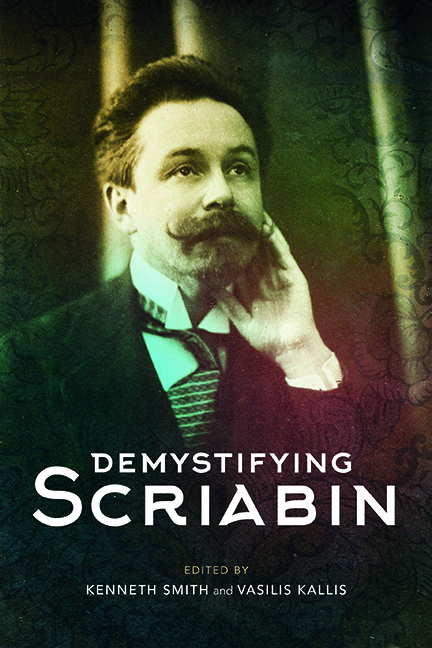12 - Scriabin’s Synaesthesia: The Legend, the Evidence,and Its Implications for MultimediaCounterpoint
Published online by Cambridge University Press: 07 October 2022
Summary
Scriabin's synaesthetic perception is one of the mostdurable and widely disseminated myths surroundingthe composer. It is reiterated in music scholarship,concert programs, performer interviews, popularscience, and on the internet. These writingsperpetuate the idea that Scriabin was a synaesthetein the modern sense of the term, implying that, whenhe heard music, he experienced visual perceptionsthat were spontaneous, uncontrollable, andneurological in origin. The myth also asserts thatthe notated part for coloured lights in Prometheus, Poem of Fire(1911) is a literal transcription of Scriabin'ssynaesthetic perception. Faubion Bowers’introduction to the widely accessible Dover score ofPrometheus isperhaps the most influential source of this myth inEnglish. Bowers described Scriabin's ability to seecolours when hearing musical pitches, adding ‘forScriabin, this photismwas natural reality […] natural and personal’, butalso ‘murkily imprecise’. Bowers explained thatScriabin attempted to externalise this strangeinternal vision in Prometheus, implying that the work'slong history of technological and aesthetic failureproves the faulty logic behind this effort.Scriabin's original tastieraper luce , or keyboard for light, waswithdrawn from the 1911 Moscow premiere of Prometheus. When the workwas first performed for the public with lights inNew York in 1915, ‘the lights flashed feebly on awhite movie screen hanging over the orchestra, withtwo colors invariably blurred into a murky neutralgrey’. Bowers’ account demonstrates how the myth ofScriabin's neurological synaesthesia leads toaesthetic judgments that shape how his colour musicis understood and realised in performance. IfScriabin's ‘synaesthesia’ was subjective andpersonal, it remains inaccessible for scholarlyanalysis. If his system for producing colour musicis arbitrary, imprecise, and burdened withhistorical failure, it can easily be replaced with alight show of a modern designer's own creation,raising thorny issues regarding authorship and theauthenticity of the combined whole.
While it is true that we will never know what Scriabinreally saw, his conception of colour music iswell-documented in primary and first-hand secondarysources. This evidence overwhelmingly indicates thatScriabin was not a synaesthete as defined byneuropsychologists today.
- Type
- Chapter
- Information
- Demystifying Scriabin , pp. 223 - 246Publisher: Boydell & BrewerPrint publication year: 2022



